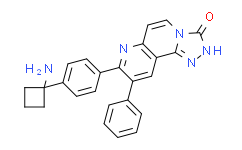| Cas No.: | 1032350-13-2 |
| Chemical Name: | MK-2206 |
| Synonyms: | MK-2206;MK-2206 Dihydrochloride;MK-2206 2HCl;MK 2206 (hydrochloride);MK2206;MK-2206 Dihydrochlor;MK2206 dihydrochloride;8-[4-(1-Aminocyclobutyl)phenyl]-9-phenyl-1,2,4-triazolo[3,4-f][1,6]naphthyridin-3(2H)-one dihydrochloride;MK-2206 HCl salt;8-(4-(1-aminocyclobutyl)phenyl)-9-phenyl-[1,2,4]triazolo[3,4-f][1,6]naphthyridin-3(2H)-one;8-[4-(1-AMINOCYCLOBUTYL)PHENYL]-9-PHENYL-1,2,4-TRIAZOLO[3,4-F][1,6]NAPHTHYRIDIN-3(2H)-ONE 2HCL;8-[4-(1-AMinocyclobutyl)phenyl]-9-phenyl-1,2,4-triazolo[3,4-f][1,6]naphthyridin-3(2H)-one Hydrochloride;MK 2206;51HZG6MP1K;8-[4-(1-aminocyclobutyl)phenyl]-9-phenyl-2H-[1,2,4]triazolo[3,4-f][1,6]naphthyridin-3-one;DSSTox_RID_83143;DSSTox_CID_28874;DSSTox_GSID_48948;8-[4-(1-aminocyclobutyl)phenyl]-9-phenyl[1,2,4]triazolo[3,4-f][1,6]naphthyridin-3(2H)-one;1,2,4-Triazolo[3,4-f][1,6]naphthyridin-3(2H)-one, 8-[4-(1-aminocyclobutyl)phenyl]-9-phenyl-;1,2,4-Triazolo[3,4-f][1,6]naphthyridin-3(2H)-one, 8-[4-(1-aminocyclobutyl)phen |
| SMILES: | C1=CC=C(C=C1)C2=C(N=C3C(=C2)C4N(C=C3)C(=O)NN=4)C5=CC=C(C=C5)C6(N)CCC6 |
| Formula: | C25H21N5O |
| M.Wt: | 407.4671 |
| Sotrage: | 2 years -20°C Powder, 2 weeks 4°C in DMSO, 6 months -80°C in DMSO |
| Description: | MK 2206 is an orally active allosteric Akt inhibitor with IC50s of 5, 12 and 65 nM for Akt1, Akt2 and Akt3, respectively. |
| In Vivo: | MK-2206 doses (480 mg/kg once a week and 240 mg/kg three times a week) can inhibit the growth of human CNE-2 xenografts in nude mice. In the two MK-2206 groups, the tumor weights are much lighter than the control group (P<0.01). Temporal body weight reduction is observed after receiving the MK-2206 treatment[1]. |
| In Vitro: | The NPC cell lines CNE-1, CNE-2, HONE-1, and SUNE-1 are treated with increasing doses of MK-2206 (0-10 μM) for 72 and 96 hours, results in dose- and time-dependent inhibition of cell viability. At 72 and 96 hours, the IC50 values of MK-2206 in CNE-1, CNE-2, and HONE-1 cell lines are 3-5 μM, and in SUNE-1, they are less than 1 μM[1]. MK-2206 alone more potently inhibits the cell growth of Ras wild-type (WT) cell lines (A431, HCC827, and NCI-H292; IC50s of 5.5, 4.3, and 5.2 μM, respectively) as compared with Ras-mutant cell lines (NCI-H358, NCI-H23, NCI-H1299, and Calu-6; IC50s of 13.5, 14.1, 27.0, and 28.6 μM, respectively), with the exception of NCI-H460, which has a PIK3CA E545K mutation (IC50, 3.4 μM)[2]. |






















